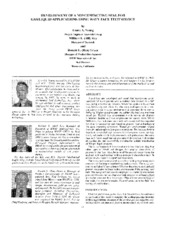| dc.contributor.other | International Pump Users Symposium (13th : 1996) | |
| dc.creator | Young, Lionel A. | |
| dc.creator | Key, William E. | |
| dc.creator | Grace, Ronald L. | |
| dc.date.accessioned | 2017-10-05T17:00:42Z | |
| dc.date.available | 2017-10-05T17:00:42Z | |
| dc.date.issued | 1996 | |
| dc.identifier.uri | https://hdl.handle.net/1969.1/164167 | |
| dc.description | Lecture | en |
| dc.description | pg. 39 | en |
| dc.description.abstract | A seal has been developed and tested that incorporates a circumferential wave pattern with a sealing dam formed on a SiC face, using a proprietary process. When run against a flat carbon face, laboratory tests show that the wavy seal operates in a non-contacting mode in a gas environment at pressures from zero to 600 psig. Higher gas pressures are achievable but have not been tested yet. Typical face temperature rise is two to six degrees Fahrenheit despite seal size or pressure for speeds from 200 to 3600 rpm. Gas leak rates are one fourth to one half that reported for other noncontacting seals based on grooved face technology at the same operating conditions. Tested gas environments ranged from air and nitrogen to low pressure propane. Testing was done in liquids that included high pressure liquid propane, water, synthetic oil, and crude oil. On high pressure liquid applications, the wavy face seal shows excellent containment of the product. Lab testing shows that the seal successfully contains the sudden introduction of 300 psi liquid propane. The wavy feature is bidirectional and is less likely to clog than other types of liftoff seal designs that employ some form of grooves in the face. Also, because of the smooth wavy shape, the seal can withstand contact without damage to the carbon face. In all test modes there is insignificant face wear. The wavy seal is employed as a safety backup to primary seals operating in flashing or nonflashing hydrocarbons. The wavy secondary seal should have a longer life than the primary seal and will prevent excessive leakage to the environment if the primary seal fails. The wavy seal can also be employed as a primary seal in low pressure blowers and as a dual seal with nitrogen or air barrier fluid at a higher pressure than the process. This ensures zero leakage of the product to the environment. Over 60 seals are in the field in a variety of applications. | en |
| dc.format.medium | Electronic | en |
| dc.format.mimetype | application/pdf | |
| dc.language.iso | en | |
| dc.publisher | Texas A&M University. Turbomachinery Laboratories | |
| dc.relation.ispartof | Proceedings of the 13th International Pump Users Symposium | en |
| dc.subject.lcsh | Pumping machinery | en |
| dc.title | Development Of A Noncontacting Seal For Gas/Liquid Applications Using Wavy Face Technology | en |
| dc.type.genre | Presentation | en |
| dc.type.material | Text | en |
| dc.identifier.doi | https://doi.org/10.21423/R1H11N | |


